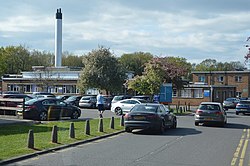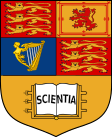Harefield Hospital
| Harefield Hospital | |
|---|---|
| Royal Brompton and Harefield NHS Foundation Trust | |
 Harefield Hospital | |
| Geography | |
| Location | Harefield, Greater London, England, United Kingdom |
| Organisation | |
| Care system | NHS England |
| Type | Specialist |
| Affiliated university | National Heart and Lung Institute at Imperial College, London |
| Services | |
| Emergency department | No Accident & Emergency |
| Beds | 149 |
| Speciality | Cardiothoracic surgery including transplantation; cardiology; respiratory medicine |
| History | |
| Opened | 1937 |
| Links | |
| Website | http://www.rbht.nhs.uk/about/our-work/harefield |
| Lists | Hospitals in England |
Harefield Hospital in Harefield, London Borough of Hillingdon, England, is part of the Royal Brompton and Harefield NHS Foundation Trust, the largest specialist heart and lung centre in the UK and among the largest in Europe.[1] Harefield's sister hospital is the Royal Brompton Hospital in Chelsea.
History
The first hospital on the site was the No. 1 Australian Auxiliary Hospital established during the First World War to treat injured Australians and New Zealander soldiers.[2] After the war Middlesex County Council decided to use the site to build a series of single-storey pavilions which opened as the Harefield Sanatorium in October 1921.[3]
Work started on a more permanent structure in 1935 and the new building was opened on 8 October 1937 by the Duke of Gloucester, with many of the wards featuring large open areas to give patients access to the fresh air.[4] The hospital joined the National Health Service in 1948.[3]
Amongst the hospital's roll call of distinguished cardiologists were Paul Wood and Walter Somerville. Arguably, the hospital's most famous surgeon was Professor Sir Magdi Yacoub, who performed the UK's first heart and lung transplant at Harefield in 1983.[5] Under the leadership of Sir Magdi Yacoub, the Harefield Hospital transplant programme had begun in 1980 and by the end of the decade he and his team had performed one thousand of the procedures, while the hospital had become the leading UK transplant centre.[6]
In a January 2008 press release, the trust announced that Harefield Hospital had become the leader in the south east of England for treating acute heart attack patients with primary angioplasty and coronary stent insertion to reduce the length of hospital stays.[7]
In the 2010 staff survey conducted by the Care Quality Commission, one staff member in five (of those who responded to the survey [8]) reported having been the subject of discrimination and one in fifty having been assaulted at work by a fellow staff member. However, "only a minority of staff said they felt work pressures, with four fifths of employees adding they would recommend the trust as a place to work or receive treatment." [9]
Facilities
The hospital advertises as being "one of the largest and most experienced centres in the world for heart and lung transplants" and having "jointly pioneered work in the development of 'artificial hearts' (also known as left ventricular assist devices or LVADs)".[10] The grounds of the hospital also house the Harefield Heart Science Centre, where research is performed into the causes and treatments of heart disease.[10]
See also
References
- ^ "Our work and hospitals". Royal Brompton & Harefield NHS Foundation Trust. Retrieved 29 August 2011.
- ^ "Royal Brompton and Harefield Hospitals history". www.rbht.nhs.uk. Retrieved 14 April 2016.
- ^ a b "Harefield Hospital". Lost Hospitals of London. Retrieved 28 May 2018.
- ^ Newbery, Maria; Cotton, Carolynne; Packham, Julie Ann; Jones, Gwyn (1996). Around Ruislip. Stroud: The Chalfont Publishing Company. ISBN 0-7524-0688-4.
- ^ "Transplant makes British medical history". On This Day. BBC News. 6 December 1983. Retrieved 29 August 2011.
- ^ "Our history". Royal Brompton & Harefield NHS Foundation Trust. Retrieved 29 August 2011.
- ^ "Press release: Patients taken to Harefield Hospital get quickest treatment for heart attack". 25 June 2008.
Patients at Harefield receive primary angioplasty – where a thin tube (catheter) is used to unblock coronary arteries and a small metal stent put in place to keep the artery open
- ^ "NHS Staff Surveys".
- ^ "Harefield Hospital's CQC good- despite bullying complaints".
- ^ a b "Harefield Hospital". Royal Brompton & Harefield NHS Foundation Trust. Retrieved 29 August 2011.


